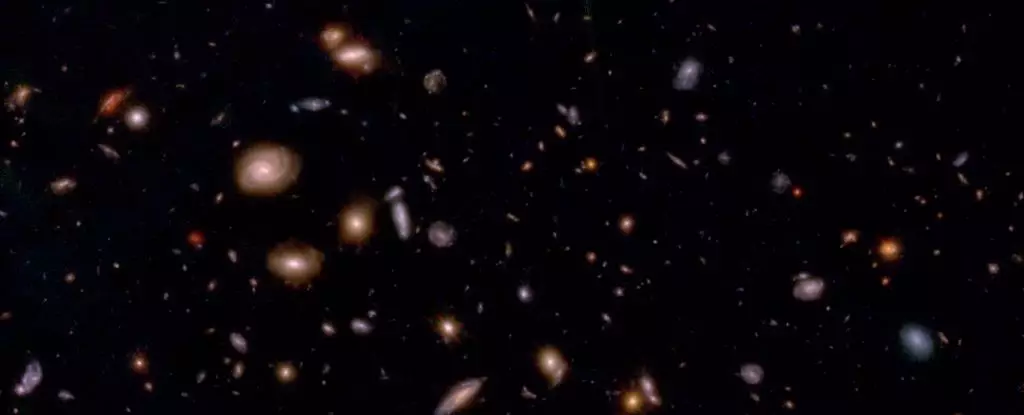The Universe has long captured the human imagination, serving as both a frontier for exploration and a canvas for our scientific inquiries. As we attempt to decode its intricate laws, we stumble upon surprising anomalies that challenge our foundational understanding. A particularly intriguing conundrum arises when we survey galaxies in the cosmos: an unusual majority of these celestial bodies appear to be rotating in the same direction. This undermines a fundamental cosmological assumption—that galactic rotations are random and uniformly distributed. Why does this matter? It suggests that we may not fully grasp the physics behind the cosmos’ grand design, a realization that could have profound implications for everything from the structure of galaxies to the growth of the Universe itself.
The Expected Chaos of Galactic Spin
According to conventional cosmological models, we would anticipate a diverse array of galactic spins. Picture a swirling cauldron, where galaxies whirl and twirl in every conceivable direction, yielding a roughly balanced ratio of clock- and counterclockwise spins. Yet, as astronomer Lior Shamir from Kansas State University points out, this is not what our observational data reveals. Instead, we face a puzzling disparity: countless galaxies seem to favor one rotational direction over another. As scientists sift through this enigma, the implications of their findings resonate deeply, hinting at a possible reevaluation of established cosmological theories and models.
Two Intriguing Hypotheses
Shamir posits two primary explanations for this unexpected rotational bias. The first, perhaps the more revolutionary of the two, suggests that the Universe itself could have been born with a rotational momentum. This idea aligns with innovative theories such as black hole cosmology, which posits that our Universe might actually be the interior of a black hole. If this theory holds water, it would signal a reformation of how we understand cosmic origins and evolution—one that steps beyond traditional narratives that have dictated our understanding of the Universe’s birth and fundamental nature.
On the other hand, Shamir offers a less dramatic yet still significant possibility: that the observed spin asymmetry may stem merely from our vantage point within the Milky Way. This perspective might suggest that the rotation of our own galaxy plays a more substantial role in the observations than previously acknowledged. Addressing this will not just clarify the galactic spin question; it could illuminate other cosmic puzzles, such as discrepancies in measurements of cosmic expansion rates—another crucial element of our understanding of the balmy universe we inhabit.
Data from the James Webb Space Telescope: A New Dawn in Cosmology
Shamir’s research, supported by data gleaned from the James Webb Space Telescope (JWST) Advanced Deep Extragalactic Survey (JADES), enables him to analyze over 263 galaxies, whose light has traversed the universe for between 5 and 10 billion years. One critical takeaway from this study is how pronounced the directional bias appears: 158 of these galaxies rotate clockwise, while only 105 rotate counterclockwise. These figures are stark and cannot merely be dismissed as random variance; they represent a significant departure from what we’d expect if the Universe were truly isotropic.
This groundbreaking analysis reveals the potential of the JWST to transform our cosmological studies, as even casual observers can appreciate these findings. The power of this telescope extends beyond its capacity to collect distant light, allowing it to unveil cosmic structures that have remained hidden in the blurred observations of previous instruments.
What Lies Ahead: Rethinking Our Cosmic Perspective
As scientists like Shamir delve deeper into the implications of their discoveries, the prospects of reevaluating longstanding theories grow more tangible. If the asymmetry in galactic spin proves linked to the rotational influence of our galaxy, it could recalibrate our understanding of the cosmic landscape—the filaments of dark matter weaving through space, the very architecture of galaxies, and even the metrics we use to measure cosmic distances.
The excitement surrounding this kind of inquiry exemplifies the essence of scientific discovery: the persistent challenge to question, examine, and sometimes completely overhaul our understandings of the Universe. Each revelation—not merely a series of numbers on a screen but a bold dive into the unknown—urges us to redefine what we know about our cosmic residence. None can deny the importance of continuing this exploration. Embracing the enigmatic nature of cosmic spin opens doors to vast realms of inquiry, echoing through the annals of astrophysics and beyond.


Leave a Reply